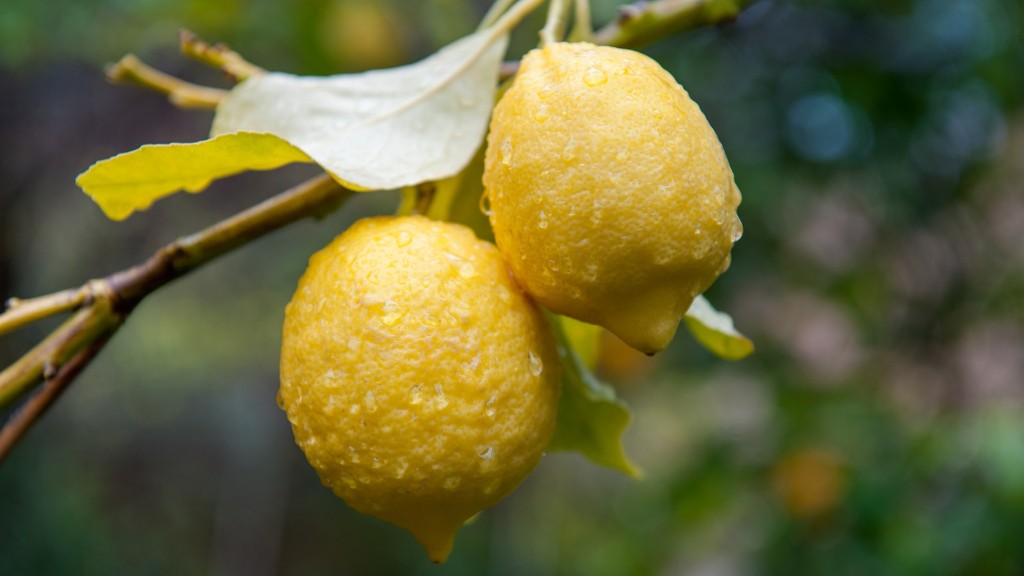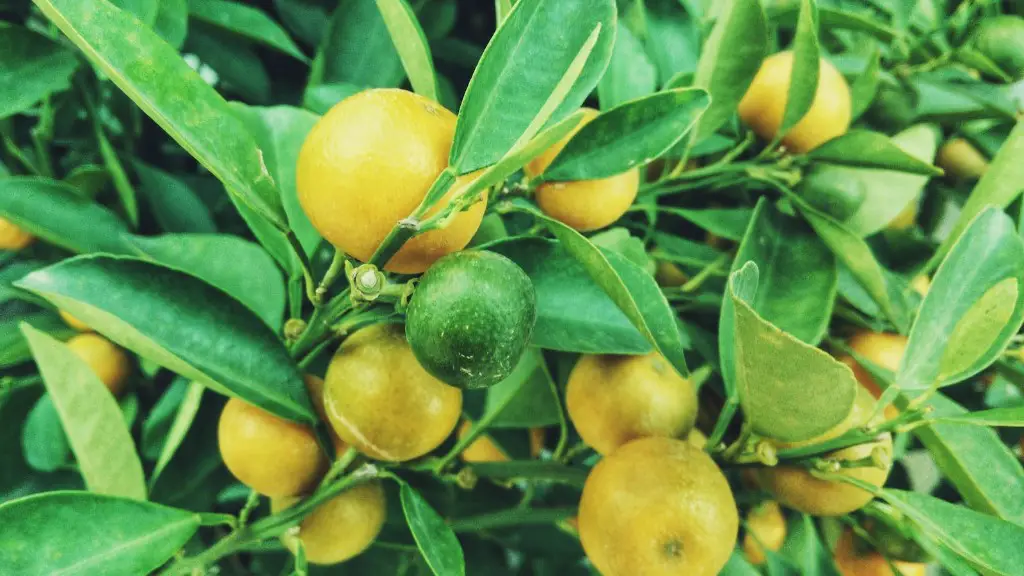With an optimal mix of soil, adequate sunlight, and proper watering, growing and caring for a lemon tree is quite manageable. To optimize the tree’s growth, start by understanding the basics of lemon tree planting and care. Here, we will provide an overview of the requirements for planting and caring for a lemon tree.
If you’re looking to ensure lemon tree growth, start by purchasing a tree from a reputable nursery that is properly labeled as a lemon tree. The tree should have a densely branched top and a smooth, pale-gray bark. Once the tree has been acquired, you’ll want to find a place to plant it. Lemon trees thrive in well-draining soil and in full sunlight, making an area facing southeast a great option. Ensure that the ground is not overly saturated with water, as this could lead to root rot.
Next, you’ll want to dig a hole in the ground of the selected area that is two times as wide as the root mass yet not deeper than the container the tree came in. After the hole is dug, place the root mass in the hole, evenly disperse the soil over the root mass, and firmly compress the soil back into the hole. As for watering, lemon trees should be watered until the soil is completely saturated, and this should take place one to three times per week.
In addition to planting and watering, lemon tree care includes fertilizing and pruning. A good practice to follow when it comes to fertilizing is to give the tree a balanced fertilizer like 6-6-6 six weeks after planting. As for pruning, it should take place in the late fall or early winter in order to contain the size of your lemon tree. When pruning, trim the stray and congested branches, as well as overly long branches.
Finally, other lemon tree care practices include pest prevention and protection against cold weather. To protect against pests such as spider mites, aphids, scale, and mealybugs, use a natural insecticidal soap every two weeks. In terms of cold weather, mulching and covering the lemon tree can help protect it from freezing temperatures.
Pruning
Pruning is essential for maintaining a healthy lemon tree. Pruning should take place in the late fall or winter, when the tree is not actively growing. Pruning helps shape the tree and limits its size, resulting in a more even production of lemons. When pruning, trim off any congested, straggly, and overly long branches. Doing so will allow for better airflow and sunlight penetration, ultimately promoting bloom and fruit formation.
In terms of tools, cutting back branches requires pruning shears. Anvil cutters, which are heavy scissors, should be used for tightening up the branches and removing dead wood. While pruning, it is important to dispose of any waste material properly. This will help protect against the spread of disease and avoid attracting unwanted pests.
When it comes to pruning, it is important to remember to prune with purpose. This means that branches should be pruned selectively, with an understanding of the extent of pruning that can be done safely. Removing too many branches can expose the tree to damage and inhibit lemon production.
Finally, it is important to take into account the size of the tree, frequency of blooming and fruiting, and the number of lemons it produces. Keep in mind that lemon trees can begin to bear fruit within three to four years of planting, with a mature tree typically yielding between five and 50 lemons at a time.
Fertilizing
Fertilizing is an important component of lemon tree care. This should take place six weeks after planting, and then every six to eight weeks thereafter, using a balanced fertilizer such as 6-6-6. Additionally, it is important to remember to avoid fertilizer that has too much nitrogen as this can damage the tree.
It is also crucial to apply fertilizer evenly around the base of the tree according to the instructions on the product label. Otherwise, applying too much fertilizer can lead to leaf burn and inhibit lemon production. Furthermore, it is important to remove any excess fertilizer that is left over after application, as this can lead to salty, unpleasant soil.
As for the amount of fertilizer to use, the general rule of thumb is ¼ to ½ cup of fertilizer for every mature lemon tree and 1/8 cup of fertilizer for a younger tree. Finally, it is important to avoid fertilizing during dry periods, as this can lead to root damage.
Pest Prevention
Common pests of the lemon tree include aphids, scale, mealybugs, and spider mites. To prevent the spread of pests, the area surrounding the lemon tree should be regularly monitored and kept free of leaves, old fruit, and other debris. Additionally, regular inspection of the tree’s foliage should take place to ensure that the tree is pest-free.
It is important to remember that the best form of protection and pest prevention is to ensure that the lemon tree is healthy. This can be done by providing the tree with ample moisture, light, and fertilizer. If signs of pests present, it is best to use natural insecticidal soap every two weeks to minimize the damage and protect the tree in the long-term.
Although natural insecticidal soap is typically considered the safest approach for pest prevention and treatment, some individuals may opt for chemical sprays to manage a severe infestation. However, it is important to note that using chemical sprays too often can lead to negative environmental impacts and adverse effects on the health of the lemon tree.
Protection Against Cold Weather
It is important to provide protection against freezing temperatures as they can significantly damage the lemon tree and inhibit its fruit production. Therefore, mulching and covering the tree prior to frost is highly recommended as it serves as an insulating blanket and minimizes the risk of root damage. An easy way to cover the tree is to use straw or burlap, as these materials are cheap and readily available.
When mulching the lemon tree, remember to keep the mulch away from the base of the trunk and apply a layer of thick plastic or burlap between the mulch and the trunk to avoid contact with the cold air. Furthermore, if temperatures are expected to drop to above freezing, potted lemon trees can be moved indoors for extra protection.
When indoors, regular watering and light should be provided to ensure the vitality of the tree. Finally, if temperatures are expected to reach below freezing for extended periods of time, some individuals may opt for handheld heating devices, such as space heaters or electric blankets, to keep the tree warm.
Harvesting
The lemon typically take approximately eight months to fully mature and yellow in color, but they can be picked at any point during the process. When harvesting, carefully cut the lemon off of the branch with a pair of pruning shears or scissors. Additionally, harvesting at the right time and in the right way can lead to a larger yield of lemons.
Lemons can be picked when they’re still green, but this is not recommended, as green lemons typically have an inferior flavor and shelf-life compared to those that have been allowed to fully ripen. Alternatively, lemons that are still too green can be left to ripen on the tree for a sweeter, more flavorful fruit.
In addition, it is important to leave some lemons on the tree. This will allow the tree to continue producing fruit and maintain a healthy, renewable ecosystem. Finally, it is important to store any harvested lemons properly. This will help to retain their freshness and flavor.
Storage
Lemon storage is important for both preserving the lemons and ensuring that they keep their freshness. Before storing, the lemon should be washed and dried in order to remove any dirt or debris. Afterward, the best way to store lemons is in the refrigerator. Store them either in a plastic bag or in their own container, with each lemon separated from the next to ensure air flows freely.
Lemon storage is also important for protecting against pitting and bruising. When storing lemon slices, place them between two paper towels and squeeze them gently to remove excess juices, as this will prevent them from sticking together. This will also help prevent oxidation and degradation of the lemons.
For longer storage periods, use air-tight bags and containers. Additionally, it is important to avoid freezing lemons as they can enter a state of dormancy and lose their flavor. Finally, when storing lemons, each should be inspected for proper texture, aroma, and taste.





